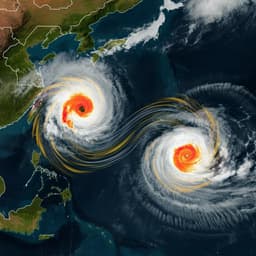Introduction
Accurate seasonal forecasts of tropical cyclone (TC) landfall along the densely populated South China coast are crucial for disaster preparedness and mitigation. The South China Sea is a high-value at-risk region, encompassing the world's largest megacity and a significant portion of global shipping, making accurate and timely TC landfall predictions economically and socially vital. Current forecasting methods, primarily relying on El Niño-Southern Oscillation (ENSO) sea surface temperature (SST) predictability, are typically issued only shortly before the TC season (March/April) and often at the basin scale rather than focusing on landfall. This limits the time available for effective preparedness measures. The interannual variability of TC activity in the western North Pacific is linked to ENSO, but existing models, which are all ENSO-based, struggle with long-range prediction. This research explores the potential of subsurface ocean temperature as a novel long-range predictor, capitalizing on its established role in seasonal prediction and its known ability to precede surface ENSO signals. The study aims to demonstrate a significant advance in forecast lead time for this critical region, offering earlier warnings and improving societal resilience.
Literature Review
Existing literature highlights the strong correlation between tropical cyclone activity and ENSO. While ENSO's influence is widely acknowledged, its direct contemporaneous correlation with basin-wide TC counts is weak. Delayed suppression of TC activity has been reported in response to strong El Niño events due to changes in large-scale circulation. Seasonal forecasting models for South China landfall frequency primarily rely on ENSO SST predictability, but these are limited by the short lead times before the TC season. The use of subsurface ocean temperatures in seasonal prediction has shown promise for phenomena like the Indian Summer Monsoon rain and Atlantic hurricane activity, but with relatively short lead times (3 months or less). The current study aims to push these boundaries and demonstrate a year-ahead forecast for South China TC landfall using Pacific subsurface ocean temperature.
Methodology
The study utilized tropical cyclone landfall data from multiple sources (China Meteorological Administration, Joint Typhoon Warning Center, Hong Kong Observatory, Japan Meteorological Agency) focusing on landfall events in South China (18°N–23°N, longitude >109°E). A South China landfall event was defined as the cyclone's position being within 200 km of the mainland China coast. The dataset included cyclones with lifetime maximum intensity >13 ms−1. Subsurface ocean temperature data were obtained from three sources: Met Office Hadley Centre EN4 objective analyses (primary), ECMWF ocean reanalysis system (ORAS5), and Global Ocean Data Assimilation System (GODAS). Sea surface temperature data were sourced from the Hadley Centre Sea Ice and Sea Surface Temperature data set (HadISST). Reanalysis data for geopotential height and wind speed came from the European Centre for Medium-Range Weather Forecasts (ERA5). A subsurface temperature index (subNiño4) was defined as the average temperature anomaly between 100-300 m depth in a specific region of the equatorial Pacific near the date line. The correlation between the subNiño4 index (from June-August of the preceding year) and the following year's South China landfall count (May-November) was analyzed using Pearson's correlation coefficient. A linear regression model, chosen over a Poisson regression model due to a more linear relationship between the predictor and the landfall counts, was developed using leave-one-out cross-validation to assess the model's predictive skill. Double cross-validation was further employed to account for potential bias in predictor selection. The model's performance was evaluated against a climatology baseline using a skill score based on root mean squared error (RMSE).
Key Findings
A strong anti-correlation (r = 0.67, p < 0.001) was found between the prior summer's (June-August) subNiño4 index and the following year's South China tropical cyclone landfall count. This correlation is robust across different TC data sources. The correlation was not found with the preceding year's sea surface temperature, highlighting the importance of subsurface temperature information. The region of significant correlation extends across the equatorial Central Pacific, similar in lateral extent to the Niño 4 index. The optimal predictor box was slightly offset from the initial Niño 4 box but still within the same depth range (100-300m) and time window (JJA-1). Double cross-validation yielded a correlation of 0.65 (p<0.001) and a skill score of 23% against climatology, comparable to existing forecasts issued in spring. Analysis of SST and atmospheric circulation anomalies linked negative subNiño4 anomalies to a La Niña-like pattern, resulting in enhanced northwestward steering winds favoring South China landfalls. The 500 hPa zonal wind anomaly showed consistent enhancement of the westward steering towards South China, while other variables (SST, vertical wind shear, low-level vorticity, mid-level relative humidity) exhibited varied and sometimes opposing effects across different regions. The subNiño4 index also showed a correlation with basin-wide accumulated cyclone energy (ACE), although the correlation with the total number of tropical cyclones in the Northwest Pacific basin was weak. The prior summer subNiño4 index is also correlated with the following year's mean Niño 3.4 index (r=0.53, p<0.001), demonstrating that the subsurface index precedes and potentially drives the surface ENSO conditions during the TC season.
Discussion
The strong predictive skill of the subNiño4 index, comparable to existing forecasts yet available a year earlier, represents a substantial advancement in TC landfall forecasting for South China. The finding that subsurface temperature anomalies, preceding surface ENSO conditions, are better predictors than in-season ENSO signals suggests the importance of capturing the initial phase of ENSO development. The mechanism appears to involve the eastward advection and upwelling of subsurface temperature anomalies from the subNiño4 region, leading to surface SST patterns that influence atmospheric circulation. The resulting La Niña-like pattern, with enhanced northwestward steering winds, is consistent with theoretical models of atmospheric response to equatorial diabatic heating. The slightly lower skill compared to spring forecasts is likely due to the reduced influence of immediate atmospheric forcing and possible overfitting in the shorter-lead-time models. The independence of the subNiño4 index from in-season SST-landfall correlations through the damping effect of cloudiness highlights its value as a leading indicator.
Conclusion
The study successfully demonstrates the utility of the subNiño4 index, a subsurface ocean temperature anomaly index in the Pacific warm pool, as a robust long-range predictor of South China tropical cyclone landfall. Its predictive power, exceeding that of in-season ENSO signals, stems from its ability to anticipate surface ENSO conditions and their subsequent impact on atmospheric steering. The near-year-ahead forecast capability, with comparable skill to spring forecasts, represents a significant step forward in TC forecasting. Future research should explore the application of this approach to other regions and investigate the incorporation of subNiño4 into dynamical forecasting models to further refine predictive capabilities.
Limitations
The study primarily focuses on the correlation between subNiño4 and South China landfall counts. While the mechanism linking subsurface temperature anomalies to atmospheric steering is discussed, a more detailed mechanistic understanding through coupled model simulations could strengthen the interpretation. The model's predictive skill, although significant, might be subject to decadal variability, as indicated by the rolling correlation analysis. Further investigations into this temporal variability are needed. The definition of landfall, while comprehensive, might not capture all the subtle impacts of near-coastal cyclones.
Related Publications
Explore these studies to deepen your understanding of the subject.







